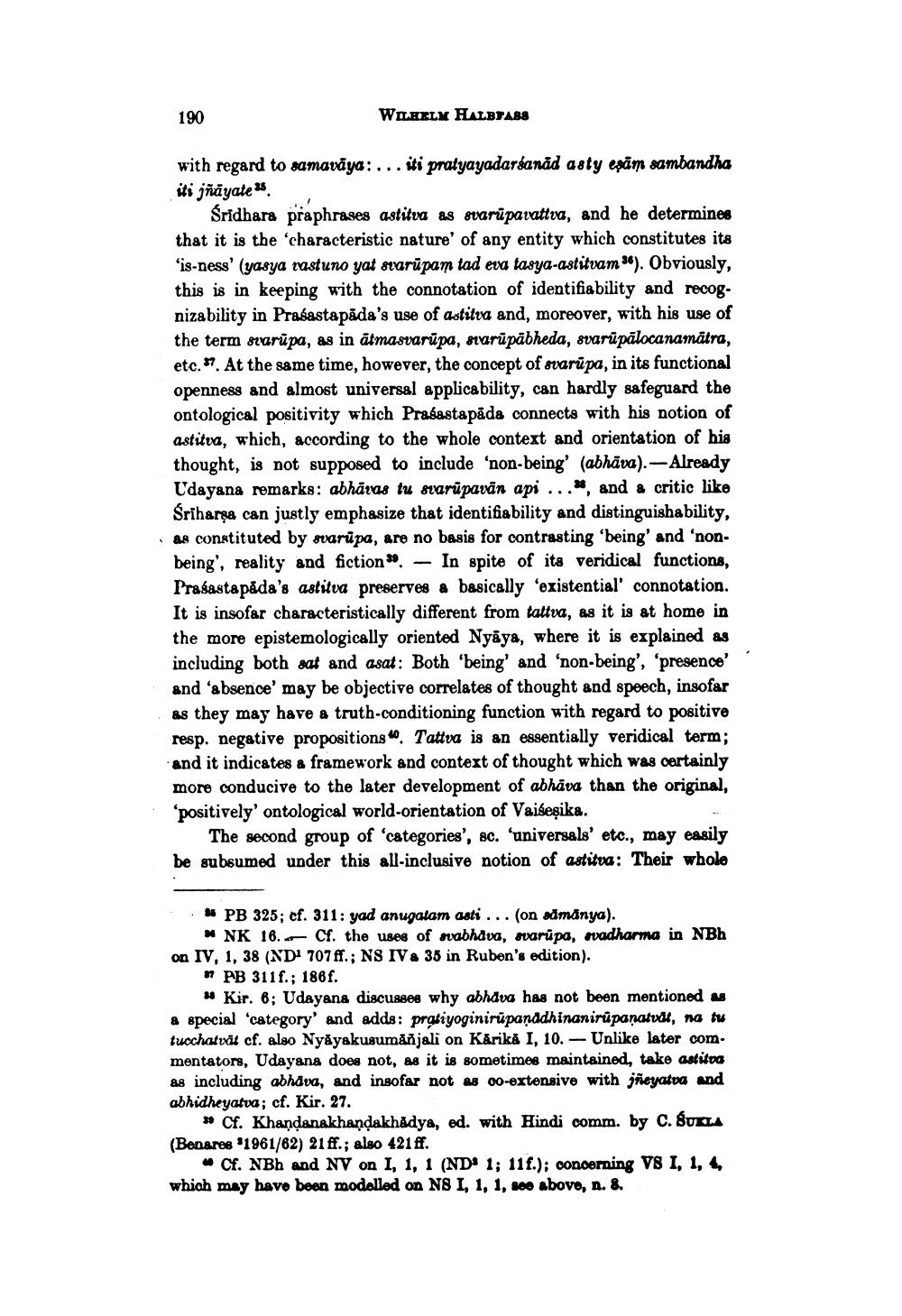________________
190
WILHELM HALBFA88
with regard to samavāya:... iti pratyayadarsanad asty eşām sambandha iti jñāyates.
Sridhara praphrases astitva as svarūpavattva, and he determines that it is the characteristic nature of any entity which constitutes its ‘is-ness' (yasya rastuno yat svarūpam tad eva tasya-astitvam *). Obviously, this is in keeping with the connotation of identifiability and recognizability in Prasasta pāda's use of Astitva and, moreover, with his use of the term svarūpa, as in atmasvarūpa, sarūpābheda, svarūpālocanamätra, etc. 7. At the same time, however, the concept of svarūpa, in its functional openness and almost universal applicability, can hardly safeguard the ontological positivity which Prasastapäda connects with his notion of astitva, which, according to the whole context and orientation of his thought, is not supposed to include 'non-being' (abhäva). - Already Udayana romarks: abhāras tu starūpavān api ...*, and a critic like
Śriharşa can justly emphasize that identifiability and distinguishability, · as constituted by svarūpa, are no basis for contrasting ‘being' and 'non
being', reality and fiction". – In spite of its veridical functions, Prasastapäda's astitva preserves a basically 'existential' connotation. It is insofar characteristically different from tattva, as it is at home in the more epistemologically oriented Nyāya, where it is explained as including both sat and asat: Both 'being' and 'non-being', 'presence' and 'absence' may be objective correlates of thought and speech, insofar as they may have a truth-conditioning function with regard to positive resp. negative propositions". Tattva is an essentially veridical term; and it indicates a framework and context of thought which was certainly more conducive to the later development of abhāva than the original, 'positively' ontological world-orientation of Vaišeşika.
The second group of 'categories', sc. 'universals' etc., may easily be subsumed under this all-inclusive notion of astitva: Their whole
# PB 325; cf. 311: yod anugatam asti ... (on sámánya).
* NK 16. Cf. the uses of nabhava, svarūpa, wadharma in NBh on IV, 1, 38 (NDI 707 ff.; NS IVa 35 in Ruben's edition).
" PB 311f.; 186f.
* Kir. 6; Udayana discusses why abhava has not been mentioned a a special 'category' and adds: pratiyoginirūpaņddhinanirūpanatvde, na tu tucchatuit cf. also Nyåyakusumáñjali on Kårika I, 10. -Unlike later commentators, Udayana does not, as it is sometimes maintained, take astitva as including abhava, and insofar not as co-extensive with jñeyatva and abhidheyatva; cf. Kir. 27.
» Cf. Khandanakhandakhadya, ed. with Hindi comm. by C. SUKLA (Benares '1961/62) 21 ff.; also 421ff.
· Cf. NBh and NV on I, 1, 1 (ND: 1; 11f.); concerning V8 I, 1, 4, which may have been modelled on NS I, 1, 1, se above, n. 8.




